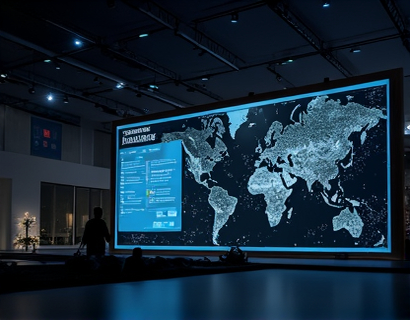Elevate Your Brand's Digital Presence with Next-Gen QR Code Solutions for Business and Social Media
In the rapidly evolving digital landscape, businesses and social media managers are constantly seeking innovative ways to enhance their online presence and engage more effectively with their audience. One such solution that has gained significant attention is the use of next-generation QR codes, designed to streamline information sharing and boost customer interaction. These advanced QR codes, often referred to as enhanced or intelligent QR codes, offer a range of features that traditional QR codes lack, making them an invaluable tool for modern marketing strategies.
The primary advantage of next-gen QR codes lies in their ability to store and deliver more complex and dynamic content. Unlike standard QR codes that typically link to a static URL, these advanced codes can direct users to interactive web pages, videos, augmented reality experiences, and even real-time data updates. This capability allows businesses to create more engaging and informative content, thereby enhancing user experience and fostering stronger connections with their audience.
Understanding Next-Generation QR Codes
Next-generation QR codes, also known as intelligent QR codes or dynamic QR codes, are a significant evolution from the original QR code technology. These codes are generated through a server-side process, which means that the content linked to the QR code can be updated in real-time without the need to print new codes. This flexibility is particularly beneficial for businesses that need to frequently update information, such as promotions, event details, or product information.
One of the key features of next-gen QR codes is their ability to encode a wide variety of data types, including URLs, text, contact information, and even geo-location data. This versatility allows brands to tailor their QR codes to specific marketing goals and audience preferences. For instance, a retail brand can use a QR code to provide customers with a personalized shopping experience, offering product recommendations based on their location or previous purchases.
Enhancing Customer Interaction
The interactive nature of next-gen QR codes makes them an excellent tool for enhancing customer interaction. By placing these codes in strategic locations, such as store windows, product packaging, or in-store displays, businesses can invite customers to engage with their brand in a more meaningful way. When scanned, these QR codes can trigger a range of experiences, from watching a product demo video to accessing exclusive content or entering a contest.
For example, a fashion brand can place a dynamic QR code on a mannequin in a store window. When scanned, the code could lead to a virtual try-on feature, allowing potential customers to see how the clothing would look on them without physically trying it on. This not only enhances the shopping experience but also provides valuable insights into customer preferences and behaviors.
Streamlining Information Sharing
In addition to enhancing customer interaction, next-gen QR codes significantly streamline the process of sharing information. Traditional QR codes often lead to long URLs or generic landing pages, which can be uninviting and may result in high bounce rates. In contrast, dynamic QR codes can direct users to optimized, branded landing pages that are designed to convert. These pages can include clear calls-to-action, detailed product information, and seamless checkout processes, all of which contribute to higher engagement and conversion rates.
Moreover, the server-side generation of dynamic QR codes allows for the inclusion of tracking and analytics. Businesses can monitor how many times a QR code is scanned, where the scans originate from, and even track user behavior on the linked page. This data is invaluable for refining marketing strategies and measuring the effectiveness of QR code campaigns.
Boosting Social Media Engagement
Social media platforms are a critical component of any digital marketing strategy, and next-gen QR codes can play a pivotal role in boosting engagement on these platforms. By integrating QR codes into social media content, businesses can bridge the gap between online and offline interactions, creating a more cohesive and engaging customer journey.
For instance, a brand can include a dynamic QR code in a Instagram post that, when scanned, directs followers to a exclusive behind-the-scenes video or a special offer. This not only increases the likelihood of users interacting with the post but also encourages them to share the content with their own networks, amplifying the brand's reach.
Additionally, QR codes can be used to create interactive social media challenges or contests. A brand can generate a QR code that, when scanned, prompts users to participate in a photo contest or share their own content using a specific hashtag. This type of engagement not only increases brand visibility but also fosters a sense of community among followers.
Customization and Branding Opportunities
One of the most appealing aspects of next-gen QR codes is their customization potential. Brands can design QR codes that match their visual identity, incorporating their logo, color scheme, and branding elements. This level of customization ensures that the QR code is not just a functional tool but also a branding asset that reinforces the brand's image and message.
For example, a luxury brand can create a QR code with a sleek, minimalist design that aligns with its high-end aesthetic. When scanned, the code could lead to an exclusive microsite or a virtual product showcase, providing a seamless and premium customer experience. This approach not only enhances the perceived value of the brand but also leaves a lasting impression on the customer.
Implementing Next-Gen QR Codes
Implementing next-gen QR codes into your marketing strategy involves several steps. First, choose a reliable provider that offers dynamic QR code generation services. These providers typically offer user-friendly interfaces and a range of customization options to suit your brand's needs.
Once you have selected a provider, create your QR code by inputting the desired content and customizing the appearance to match your brand. The provider will then generate a unique QR code that can be used across various marketing channels, from physical materials to digital platforms.
To maximize the effectiveness of your QR code campaigns, it's crucial to place them in high-traffic areas and promote them through your social media channels. Encourage your audience to scan the codes by highlighting the benefits and experiences they can gain from doing so. Regularly monitor the performance of your QR codes using the tracking data provided by your provider, and adjust your strategy based on the insights gained.
Conclusion
Next-generation QR codes represent a powerful tool for businesses and social media managers looking to elevate their digital presence and enhance customer engagement. By offering dynamic, customizable, and interactive experiences, these codes can help brands stand out in a crowded digital landscape and build stronger relationships with their audience. As technology continues to evolve, the potential applications of next-gen QR codes will only expand, making them an essential component of any forward-thinking marketing strategy.










































